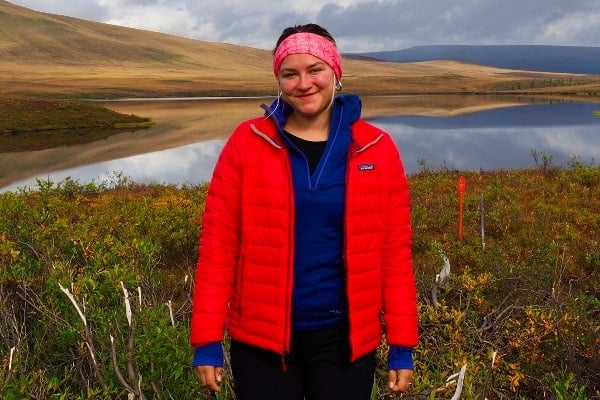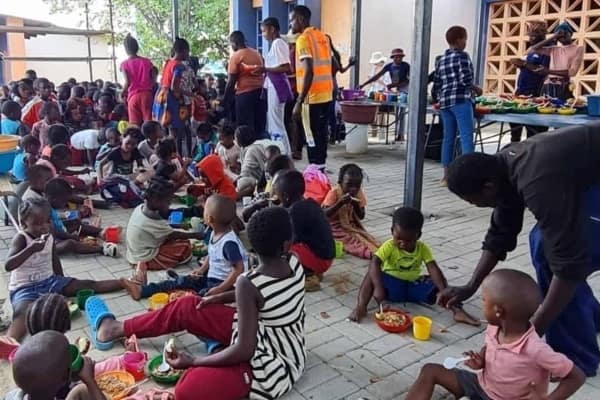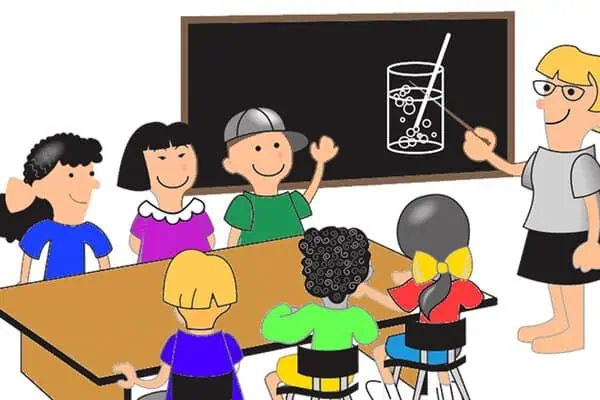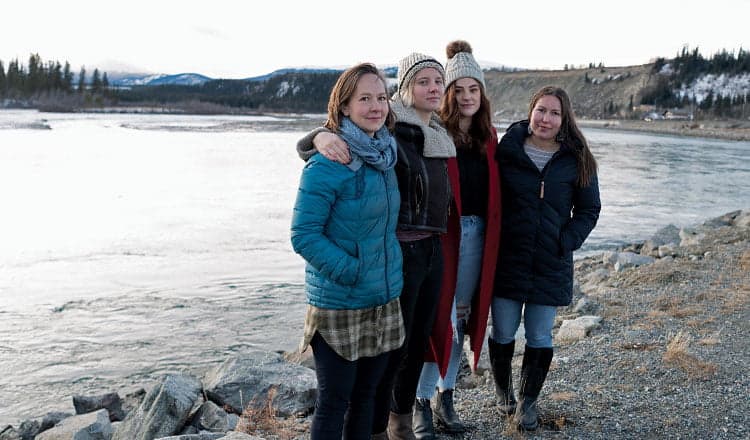Last year, when I arrived in the Yukon, I saw an article on the Ember Fire Academy, a Yukon Government Protective Service program. There were images of women breaking apart cars and fighting fires and I thought, Wow, what an incredible experience and tasked myself with working towards getting a spot in the 2018 training.
What is the Ember Fire Academy?
It’s a free, intensive program for women to experience the challenging task of being a firefighter. The intention is to promote firefighting as a career option for women and to encourage them to volunteer within the Yukon’s various emergency services.
The weeklong training is female-led, with the support of both male and female staff, working on the operations of firefighting scenarios. Kiara Adams, chief of the Ember Academy (the only female structural firefighter in the Yukon), and two other female firefighters from North Vancouver, were the primary instructors.
Twelve female recruits, ranging from 17 to 37 years old—fresh from high school, to working moms—attended the 4th Ember Fire Academy that gave the women an opportunity to push themselves.
The experience
Day 1
On the first morning, a group of strangers came together at the Golden Horn Volunteer Fire Department (GHVFD) located just outside Whitehorse city limits, near Carcross cut-off. After introductions, safety briefing and physical training, the women began their education on the use of Personal Protective Equipment (PPE) and the Self-Contained Breathing Apparatus (SCBA)—vital equipment for all structural firefighters.
We learned how to wear and use the equipment, and after lunch it was time to utilize the search drill classroom instruction in a practical environment. Getting used to being covered completely in heavy equipment and breathing as though you’re in a scuba diving situation can be intimidating. To learn search drill technique, we had to experience what it would be like if a room was filled with smoke (without actually simulating it). This meant putting garbage bags over the full SCBA and PPE.
For anyone, like myself, with a fear of confined spaces, this was one of the biggest challenges to face. As I convinced myself that I wouldn’t suffocate (I had access to air), I had to learn to breathe and overcome the fear. My partner and I were both nervous but worked together to complete the search drills. We could not see or rely on our partners, so we learned the skills that were vital to firefighting. I surprised myself as I completed each of the tasks.
After intense search drills, Kiara Adams taught a fire-behaviour lesson, an impressive chemistry lesson and practical demonstration of what fire is and how it behaves.
Day 2
On the second day, especially for those of us who didn’t work out on a daily basis, we were certainly feeling all of those physical training burpees and pushups. After our safety briefing and physical training, we donned our gear and were driven in fire trucks to visit the Carcross Volunteer Fire Department where we would spend two days training.
At Carcross, on our first day, we worked with firefighting equipment including hydrants, extinguishers, ladders, communications, pumps and hoses. Our day wasn’t complete after the exhausting, physically demanding day. We stayed in Carcross for the evening with the wildland fire crew who set up wall tents for us.
In the evening, there was a really interesting talk about wildland firefighting, with the Yukon Government, and firefighting in the Yukon. There were demonstrations and explanations of how structural firefighting was different than wildland firefighting.
Day 3
In the morning we awoke in beautiful Carcross for another intensive day of training in technical rope rescue, hazmat and confined space. The morning was spent with the XY Charlie Crew, the First Nation wildland firefighting crew, in understanding the physical requirements for wildland service.
Afterwards, we drove to Montana Mountain where we were introduced to technical rope rescue, which pushed some trainees outside their comfort zones with height.
During lunch, Emergency Medical Services (EMS) officers gave a presentation on joining services in the communities, focusing on first aid. The afternoon was spent practising some intensive confined-space and hazmat drills, which certainly pushed my own limits of claustrophobia.
After a jam-packed two days of training in Carcross, that afternoon it was time to ride back in fire trucks to GHVFD.
Day 4
By Thursday, muscles we didn’t know we had were tired because we never used them. And we were exhausted from pushing our comfort zones and limits. Now it was time for some of the fun stuff …
After physical training, it was time to learn to do auto extrication (rescuing someone trapped in a vehicle). The Golden Horn Volunteer Fire Department provided a number of old cars for us to practice with. We started with breaking windows and working with tools, such as the Jaws of Life, to disassemble the vehicles and extricate our “patients.” The tools were heavy, but impressive in their ability to break a car to pieces.
After lunch, we focused on vehicle fires and strategies to approach and put out fires. We put on firefighting gear with oxygen and the vehicles were lit on fire. Adrenalin pulsed as we approached the vehicles with our hoses. Unable to hear, we battled flames in the heat and sun while our adrenalin was still pulsating; but honestly, we were feeling bad-ass as we extinguished the flames.
Day 5
Friday was for refining skills, bringing all of our training together to attack a fire. First we learned about the Rapid Intervention Team (RIT), the team, on crews, that assists fellow firefighters that require immediate extrication from a situation.
We practised a real-life scenario whereby, as a team, we prepared with SCBA kits, with team leaders and roles, to rescue victims inside small smoke-filled rooms. As I focused on my breathing (and not on the fact that I was entering a small space where I wouldn’t be able to see), my heart felt as though it was pumping outside of my chest.
We entered the room, focusing on the techniques we had been taught throughout the week—how to manoeuvre in a smoke-filled environment, how to communicate and search when you were unable to see more than a couple of centimetres in front of you … It took a lot of energy to focus on staying inside the room. We worked together and got our patient out.
We trained further with ladder rescue and used skills such as confined-space maneuvering, with objects such as wires in the way. The afternoon used all of our skills to conduct a fire attack scenario. GHVFD has a fire scenario trailer, which allows volunteers to practice what it’s like to be in a structural fire (with actual fire).
The scenario works on propane fire within the trailer, which has obstacles like stairs for the trainees to practice.
Day 6
The last day of training involved a fire ground scenario. All trainees, in teams, began in the hall, and as the call came in with the emergency situation, we donned our gear and got on fire trucks to go to the scenario.
We followed protocol and training, working together to combat the fire and rescue patients.
All 12 women successfully completed the fourth academy. Ember Fire Academy Chief Kiara Adams, Fire Marshall James Paterson and Deputy Fire Marshall Colin O’Neil presented our certificates.
Ember Fire Academy is an incredible opportunity for women from all backgrounds (age 16 and over) to not only gain new skills and interest in firefighting, but also to understand and believe that women are capable in any profession.
I wish I had known or been encouraged to do fire service, but in my adolescence this type of job was targeted for men. Although my fitness and age would prevent switching into a career in firefighting, I certainly am keen to join the volunteer fire service in the Yukon. The training pushed my comfort level; I did things I didn’t think I was capable of doing, and all while being told I could do it. The encouragement to add these skills to your life, moving forward, is certainly inspiring.
My favourite daily quote read by one of the instructors was this: “She needed a hero, so that’s what she became” (author unknown).
For more information about the Ember Fire Academy or about volunteer firefighting in the Yukon, contact the Yukon Fire Marshall at 867-667-8236 or visit http://www.community.gov.yk.ca/protectiveservices/volunteerism_employment.html.




